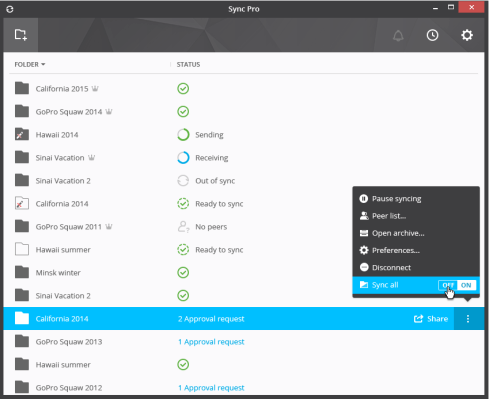BitTorrent is taking the wraps off the next phase of its strategy to turn its peer-to-peer file sharing network into a revenue-generating business, and compete more squarely against cloud-based services like Dropbox. In 2015, it will move its file-synchronising product — fittingly called Sync — out of beta as Sync 2.0, introducing a new “Pro” tier in the process for $39.99/year. And, expanding on some of the file-sending functionality of Sync, BitTorrent will introduce a new, as-yet unnamed mobile app focused specifically on large files.
As point of price comparison, BitTorrent says services from Dropbox, Microsoft and Google that are comparable to Sync cost from $83.99/year and up. You can see BitTorrent’s full breakdown below.
Erik Pounds, VP of product management for BitTorrent, tells me that Sync 2.0 will be coming out sometime in early 2015. In the works for more than a year (since the release of a Sync beta), this will be the first time that BitTorrent has introduced a paid tier to Sync, although it has several other revenue-generating products:
The news comes two days after BitTorrent announced that it was opening its Bundle paygate services to all interested parties. (Paygates let authors, musicians and other creatives add different kinds of paid tiers for portions of the content that they offer on BitTorrent.) BitTorrent takes a 10% cut on these.
It also offers “plus” versions of the BitTorrent and uTorrent clients and licenses some of its technology.
Taken together, the Sync updates and the paygates underscore how BitTorrent is trying to capitalize on those who are already regular users of BitTorrent and of Sync: enterprises and power Torrenters.
The fact that BitTorrent has a lot of enterprise users already is quite interesting, given the reputation BitTorrent has as being popular among individual consumers.
“We’ve asked our community multiple times about how they are using Sync and the we’ve received an overwhelming number of responses from users in business environments,” says a spokesperson in answer to a question about how many enterprise users there are of Sync. “Another is that the Sync client reports the amount of data it has synced back to us. We see traffic increase significantly during the work week, which can can be attributed to the amount it is being used in businesses.”
However, unless users explicitly tell BitTorrent, “We do not know who they are, so we do not know exactly what the split is between consumer and business users.”
As of August there were already 10 million installs of Sync, and now the challenge is to get some of those shifted to paying for the service, as well as sign on new converts who would like to use a peer-to-peer encrypted architecture, enabled through constant Internet connectivity, keeping assets on premise instead of putting data into the cloud.
Indeed, Pounds says that in the alpha and beta phases of Sync, the company has singled out three of the most common uses for Sync: syncing files between devices and sharing them with others; replicating files across devices controlled in an IT environment; and sending large files to another person.
Sticking to a freemium model, BitTorrent will add more features to both to the free and paid tiers of Sync 2.0. Free users will get an easier way to share and sync folders, a better UI, new tablet apps for Android and iOS (right now it’s the same apps across phones and tablets). Throughout all of this, there are no restrictions on folder sizes for free users (a contrast to cloud-based services that cap free usage as a lever to encourage users to pay).
For those who want to upgrade to the Pro version, they will get a free 30-day trial period, and then advanced access to terabit-sized, very large folders, letting users access individual files within them.
Pro users can also control folder permissions and ownership, automatic synchronization across devices with all devices connected with a common identity, and priority technical support. The aim with this is to set up the services for enterprises and make them more IT-manager friendly.
As for the new app that will be aimed at helping users send large files on mobile devices, Pounds says that this will be coming out sometime in the first half of 2015, “some time after Sync 2.0 launches.”
“We aren’t announcing a specific date and the branding of it is in development, as is the monetization model,” he adds.

*Pricing details for Dropbox, Google Drive, and Microsoft OneDrive
